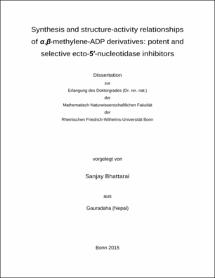Bhattarai, Sanjay: Synthesis and structure-activity relationships of α,β-methylene-ADP derivatives: potent and selective ecto-5-nucleotidase inhibitors. - Bonn, 2015. - Dissertation, Rheinische Friedrich-Wilhelms-Universität Bonn.
Online-Ausgabe in bonndoc: https://nbn-resolving.org/urn:nbn:de:hbz:5n-40983
Online-Ausgabe in bonndoc: https://nbn-resolving.org/urn:nbn:de:hbz:5n-40983
@phdthesis{handle:20.500.11811/6522,
urn: https://nbn-resolving.org/urn:nbn:de:hbz:5n-40983,
author = {{Sanjay Bhattarai}},
title = {Synthesis and structure-activity relationships of α,β-methylene-ADP derivatives: potent and selective ecto-5-nucleotidase inhibitors},
school = {Rheinische Friedrich-Wilhelms-Universität Bonn},
year = 2015,
month = aug,
note = {Ecto-5'-nucleotidase (ecto-5'-NT, eN, CD73, EC 3.1.3.5) is a member of the group of ecto-nucleotidases which dephosphorylate extracellular nucleotides. eN catalyzes the dephosphorylation of nucleoside monophosphates and its main substrate is AMP. Further members of the membrane-bound group of ecto-nucleotidases include nucleoside triphosphate diphosphohydrolases (NTPDases; subtypes 1, 2, 3 and 8), nucleotide pyrophosphatase/phosphodiesterases (NPPs 1-4) and alkaline phosphatases (APs; tissue non-specific, intestinal, placental and germ cell APs). NTPDase and NPPs are ATP- and ADP-hydrolyzing ecto-nucleotidases, which prevent ATP, ADP and other nucleotides from acting on purinergic P2X and P2Y receptors. They produce AMP which is further hydrolyzed by eN thereby elevating extracellular concentrations of adenosine which activates adenosine receptors.
Recently it was shown that inhibition of eN with monoclonal antibodies, siRNA, or drug-like inhibitors delays tumor growth and metastasis. Thus, eN inhibitors have potential as novel therapeutics, e.g. for melanomas, lung, prostate and breast cancers. Only very few, moderately potent eN inhibitors are currently known. In the present study we used the ADP analog α,β-methylene-ADP (AOPCP, adenosine-5-O'-[(phosphonomethyl)phosphonic acid]) as a lead structure for the development of potent, selective and metabolically stable eN inhibitors. Derivatives substituted at the N6-, C-8- or C-2-positions and/or at the methylene diphosphonate-side chain were synthesized to improve potency and metabolic stability. All new compounds were tested for inhibition of rat recombinant eN.
For the preparation of the target compounds with 2-, 6- or 8-substitution and for 2,6-disubstituted derivatives, a convergent synthetic strategy was applied which involves the initial preparation of the intermediate nucleosides followed by phosphorylation with methylenebis(phosphonic dichloride) to provide the desired AOPCP derivatives. For side-chain-modified analogs of AOPCP commercially available substituted bis(phosphonic acid) derivatives were employed for 5 phosphorylation. Altogether 60 AOPCP derivatives and analogs were obtained in good yields and high purity by an optimized method for their preparation. 6 (Ar)alkylamino-substitution, 2-amino-, 2-halo-, and 2-thioalkyl-substitution significantly improved potency. The most potent nucleotides were 2-chloro-N6-(2 chlorobenzyl)¬purine riboside-5-O-[(phosphonomethyl)¬phosphonic acid] (144, Ki= 0.34 nM), and 2-chloro-N6-benzyl--N6-methylpurine riboside-5-O'-[(phosphonomethyl)phosphonic acid] (149, Ki= 0.88 nM). The compounds displayed high selectivity versus other ecto-nucleotidases and ADP-activated P2Y receptors. They also showed high metabolic stability upon incubation with liver microsomes and blood plasma. These compounds are the most potent eN inhibitors known to date and may serve as valuable pharmacological tools to further elucidate the enzyme’s (patho)physiological roles.},
url = {https://hdl.handle.net/20.500.11811/6522}
}
urn: https://nbn-resolving.org/urn:nbn:de:hbz:5n-40983,
author = {{Sanjay Bhattarai}},
title = {Synthesis and structure-activity relationships of α,β-methylene-ADP derivatives: potent and selective ecto-5-nucleotidase inhibitors},
school = {Rheinische Friedrich-Wilhelms-Universität Bonn},
year = 2015,
month = aug,
note = {Ecto-5'-nucleotidase (ecto-5'-NT, eN, CD73, EC 3.1.3.5) is a member of the group of ecto-nucleotidases which dephosphorylate extracellular nucleotides. eN catalyzes the dephosphorylation of nucleoside monophosphates and its main substrate is AMP. Further members of the membrane-bound group of ecto-nucleotidases include nucleoside triphosphate diphosphohydrolases (NTPDases; subtypes 1, 2, 3 and 8), nucleotide pyrophosphatase/phosphodiesterases (NPPs 1-4) and alkaline phosphatases (APs; tissue non-specific, intestinal, placental and germ cell APs). NTPDase and NPPs are ATP- and ADP-hydrolyzing ecto-nucleotidases, which prevent ATP, ADP and other nucleotides from acting on purinergic P2X and P2Y receptors. They produce AMP which is further hydrolyzed by eN thereby elevating extracellular concentrations of adenosine which activates adenosine receptors.
Recently it was shown that inhibition of eN with monoclonal antibodies, siRNA, or drug-like inhibitors delays tumor growth and metastasis. Thus, eN inhibitors have potential as novel therapeutics, e.g. for melanomas, lung, prostate and breast cancers. Only very few, moderately potent eN inhibitors are currently known. In the present study we used the ADP analog α,β-methylene-ADP (AOPCP, adenosine-5-O'-[(phosphonomethyl)phosphonic acid]) as a lead structure for the development of potent, selective and metabolically stable eN inhibitors. Derivatives substituted at the N6-, C-8- or C-2-positions and/or at the methylene diphosphonate-side chain were synthesized to improve potency and metabolic stability. All new compounds were tested for inhibition of rat recombinant eN.
For the preparation of the target compounds with 2-, 6- or 8-substitution and for 2,6-disubstituted derivatives, a convergent synthetic strategy was applied which involves the initial preparation of the intermediate nucleosides followed by phosphorylation with methylenebis(phosphonic dichloride) to provide the desired AOPCP derivatives. For side-chain-modified analogs of AOPCP commercially available substituted bis(phosphonic acid) derivatives were employed for 5 phosphorylation. Altogether 60 AOPCP derivatives and analogs were obtained in good yields and high purity by an optimized method for their preparation. 6 (Ar)alkylamino-substitution, 2-amino-, 2-halo-, and 2-thioalkyl-substitution significantly improved potency. The most potent nucleotides were 2-chloro-N6-(2 chlorobenzyl)¬purine riboside-5-O-[(phosphonomethyl)¬phosphonic acid] (144, Ki= 0.34 nM), and 2-chloro-N6-benzyl--N6-methylpurine riboside-5-O'-[(phosphonomethyl)phosphonic acid] (149, Ki= 0.88 nM). The compounds displayed high selectivity versus other ecto-nucleotidases and ADP-activated P2Y receptors. They also showed high metabolic stability upon incubation with liver microsomes and blood plasma. These compounds are the most potent eN inhibitors known to date and may serve as valuable pharmacological tools to further elucidate the enzyme’s (patho)physiological roles.},
url = {https://hdl.handle.net/20.500.11811/6522}
}






